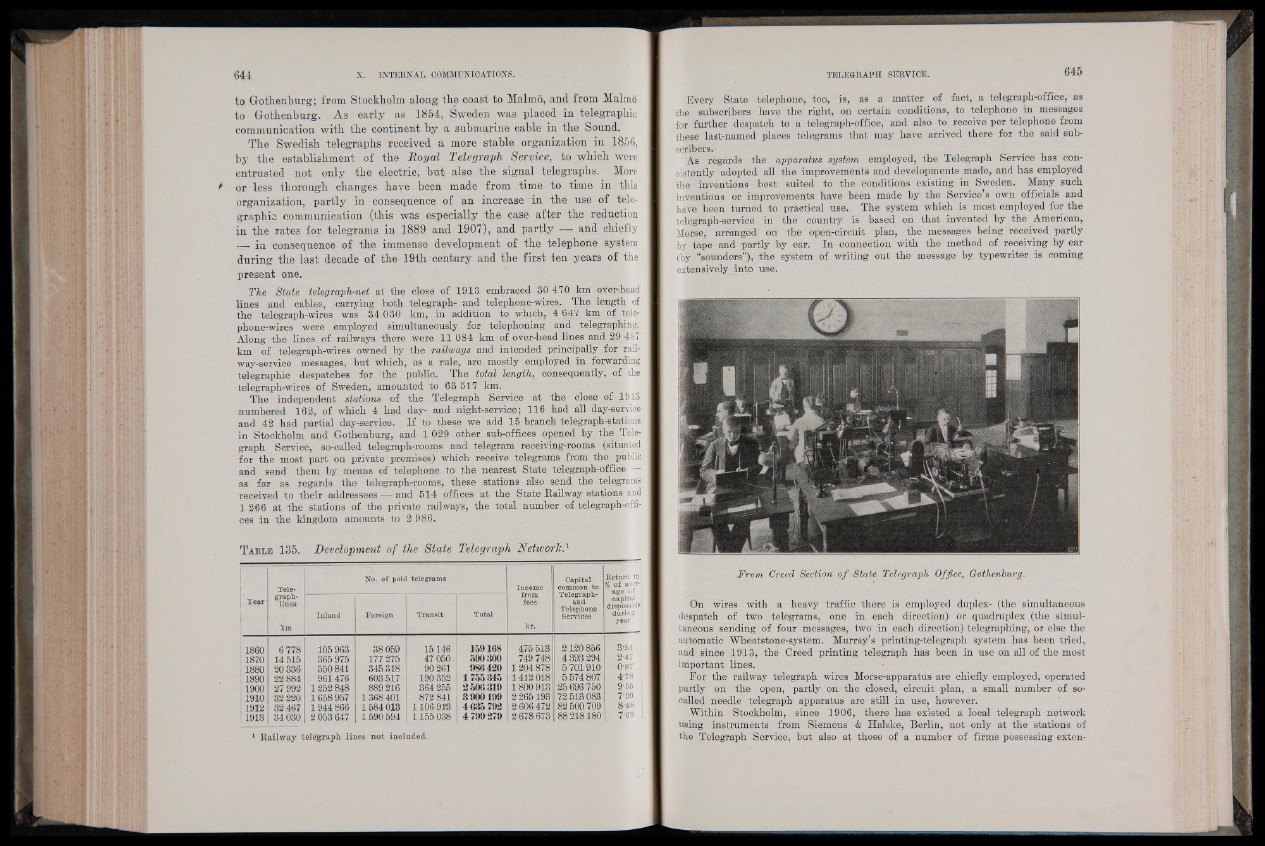
to Gothenburg; from Stockholm along the coast to Malmo, and from Malmo
to Gothenburg. As early as 1854, Sweden was placed in telegraphic
communication with the continent by a submarine cable in the Sound.
The Swedish telegraphs received a more stable organization in 1856,
by the establishment of the Royal Telegraph Service, to whioh were
entrusted not only the electric, but also the signal telegraphs. More
or less thorough changes have been made from time to time in this
organization, partly in consequence of an increase in the use of telegraphic
communication (this was especially the case after the reduction
in the rates for telegrams in 1889 and 1907), and partly — and chiefly
— in consequence of the immense development of the telephone system
during the last decade of the 19th century and the first ten years of the
present one.
The State telegraph-net at the close of 1913 embraced 30 470 km overhead
lines and cables, carrying both telegraph- and telephone-wires. The length of
the telegraph-wires was 34 030 km, in addition to which, 4 647 km of telephone
wires were employed simultaneously for telephoning and telegraphing.
Along the lines of railways there were 11 084 km of overhead lines and 29 487
km of telegraph-wires owned by the railways and intended principally for rail-
way-service messages, but which, as a rule, are mostly employed in forwarding
telegraphic despatches for 'the public. The total length, consequently, of the
telegraph-wires of Sweden, amounted to 63 517 km.
The independent stations of the Telegraph Service at the close of 1913
numbered 162, of which 4 had day- and night-service; 116 had all day-service
and 42 had partial day-servioe. If to these we add 15 branch telegraph-stations
in Stockholm and Gothenburg, apd 1 029 other sub-offices opened by the Telegraph
Service, so-called telegraph-rooms and telegram receiving-rooms . (situated
for the most part on private premises) which receive telegrams from the public
and send them by means of telephone to the nearest State telegraph-office —
as far as regards the telegraph-rooms, these stations also send the telegrams
received to their addressees — and 514 offices at the State Railway stations and
1 266 at the stations of the private railways, the total number of telegraph-offi-
ees in the kingdom amounts to 2 986.
T able 135. Development of the State Telegraph Network.1
Year
Teleg
raphlin
es
km
No. o f p aid telegrams
Income
from
fees
k r.
Capital
common to
Telegraph-
and
Telephone
In la n d Foreign T ra n sit - T o ta l Services
1860 6 778 105963 38059 15146 1 5 9 1 6 8 475 513 2120 856
1870 14 515 365 975 177 275 47 050 ■ 590 300 749 748 4 393294
1880 20 336 550 841 345318 90 261 9 8 6 4 2 0 1204 878 5 701 910
1890 22 884 961476 603 517 190 352 1 7 5 5 345 1 412 018 5 574 807
1900 27 992 1 252 848 889 216 364 255 2 5 0 6 319 1 800 913 25 696 750
1910 32 220 1 658 957 1368 401 872 841 3 9 0 0 1 9 9 2 265193 72 513 083
1912 32 467 1944 866 1 584 013 1106 91-3 4 6 3 5 792 2 606472 82 500709
1913 34 030 2 053 647 1590 594 1155 038 4 7 9 9 2 7 9 2678 673 88218180
Return in
% of average'
of
capital
disposable
' during
year I
3'51
2-47
0’87
4;78
9-55
7'30
8-45 7-69
1 Railway telegraph lines not included.
Every State telephone, to d ,' is, as a matter of fact, a telegraph-office, as
the subscribers have the right, on certain conditions, to telephone in messages
for further despatch to a telegraph-office, and also to receive per telephone from
these last-named places telegrams that may have arrived there for the said subscribers,'
.
As regards the apparatus system employed, the Telegraph Service has consistently
adopted all the improvements and developments made, and has employed
the inventions best suited to the conditions existing in Sweden. Many such
inventions or improvements have been made by the Service’s own officials and
have been turned to practical use. The system which is most employed for the
telegraph-service in the country is based on th a t invented by the American,
Morse, arranged on the open-circuit plan, the messages being received partly
by tape and partly by ear. In-connection with the method of receiving by ear
(by “sounders”), the system of writing out the message by typewriter is coming
extensively into use.
From, Creed Section o f State Telegraph Office, Gothenburg.
On wires with a heavy traffic there is employed duplex- (the simultaneous
despatch of two telegrams, one in each direction) or quadruplex (the simultaneous
sending of four messages, two in each direction) telegraphing, or else the
automatic Wheatstone-system. Murray’s printing-telegraph system has been tried,
and since 1913, the Creed printing telegraph has been in use on all of the most
important lines.
For the railway telegraph wires Morse-apparatus are chiefly employed, operated
partly on the open, partly on the closed, circuit plan, a small number of so-
called needle telegraph apparatus are still in use, however.
Within Stockholm, since 1906, there has existed a local telegraph network
using instruments from Siemens & Halske, Berlin, not only at the stations of
the Telegraph Service, but also at those of a number of firms possessing exten